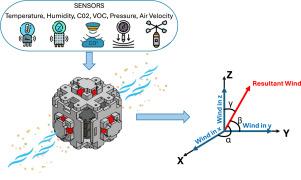Open-source three-dimensional IoT anemometer for indoor air quality monitoring
IF 2.1
Q3 ENGINEERING, ELECTRICAL & ELECTRONIC
引用次数: 0
Abstract
Ventilation in an enclosed space can significantly influence people’s comfort, health, and safety. Poor ventilation can generate temperatures dangerous to health or obstruct the dispersion of environmental pollutants, such as toxic gases or pollution. Measuring indoor environmental conditions can thus help improve the quality of the environment and protect people’s health and comfort. This work proposes the design of an open-source anemometer to measure wind speed and direction in three dimensions. The purpose of this anemometer is to monitor wind conditions in enclosed spaces and environmental conditions related to air quality and temperature. The prototype uses an array of six unidirectional flow sensors, each pointing towards a different axis. Carbon dioxide (CO), volatile organic compounds (VOC), temperature, humidity, pressure, and gas presence sensors are integrated to monitor indoor environmental conditions accurately. Measuring the vertical component of the wind provides more detailed information on wind conditions. Test results show that the device can detect variations in wind speed with a deviation of 0.25 m/s, detect changes in horizontal wind direction with a deviation of 3.7°, and detect vertical wind direction variations with a deviation of 3.02°. These measurements demonstrate that the proposed device is capable of detecting wind changes in three dimensions, validating its potential for detailed indoor airflow monitoring.

用于室内空气质量监测的开源三维物联网风速仪
封闭空间的通风对人们的舒适、健康和安全有着重要的影响。通风不良会产生对健康有害的温度,或阻碍有毒气体或污染等环境污染物的扩散。因此,测量室内环境条件有助于改善环境质量,保护人们的健康和舒适。这项工作提出了一个开源风速计的设计,可以在三维空间测量风速和风向。此风速计的目的是监测封闭空间内的风况,以及与空气质素和温度有关的环境状况。原型机使用了一个由6个单向流量传感器组成的阵列,每个传感器都指向不同的轴。集成了二氧化碳(CO2)、挥发性有机化合物(VOC)、温度、湿度、压力和气体存在传感器,可准确监测室内环境状况。测量风的垂直分量可以提供有关风况的更详细信息。测试结果表明,该装置可以检测风速变化,偏差为0.25 m/s,检测水平风向变化,偏差为3.7°,检测垂直风向变化,偏差为3.02°。这些测量表明,所提出的设备能够检测三维风的变化,验证了其详细的室内气流监测的潜力。
本文章由计算机程序翻译,如有差异,请以英文原文为准。
求助全文
约1分钟内获得全文
求助全文
来源期刊

HardwareX
Engineering-Industrial and Manufacturing Engineering
CiteScore
4.10
自引率
18.20%
发文量
124
审稿时长
24 weeks
期刊介绍:
HardwareX is an open access journal established to promote free and open source designing, building and customizing of scientific infrastructure (hardware). HardwareX aims to recognize researchers for the time and effort in developing scientific infrastructure while providing end-users with sufficient information to replicate and validate the advances presented. HardwareX is open to input from all scientific, technological and medical disciplines. Scientific infrastructure will be interpreted in the broadest sense. Including hardware modifications to existing infrastructure, sensors and tools that perform measurements and other functions outside of the traditional lab setting (such as wearables, air/water quality sensors, and low cost alternatives to existing tools), and the creation of wholly new tools for either standard or novel laboratory tasks. Authors are encouraged to submit hardware developments that address all aspects of science, not only the final measurement, for example, enhancements in sample preparation and handling, user safety, and quality control. The use of distributed digital manufacturing strategies (e.g. 3-D printing) is encouraged. All designs must be submitted under an open hardware license.
 求助内容:
求助内容: 应助结果提醒方式:
应助结果提醒方式:


